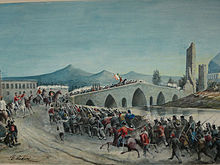Ponte dell'Ammiraglio
Admiral's Bridge Ponte dell'Ammiraglio | |
|---|---|
Stone | |
| History | |
| Construction end | 1131 |
Europe and North America | |
| Location | |
 | |
The Admiral's Bridge (
History
According to a legend, the bridge is situated in the place where the
In the
In the following centuries, besides the agriculture, the Oreto Valley became a place of manufacturing for sugar cane, paper and other production activities. The profitable production of sugar led to the creation of vast plantations of sugar cane and also to a massive deforestation in certain zones of the Conca d'Oro.[1] This problem represented the first reason for the series of floods that hit the city during the last few centuries.[1]

Since then, the bridge has been repeatedly damaged by flooding of the river. For this reason, as long ago as 1775, an attempt was made to divert the river.[1] However, it was not until 1938 that the Oreto was definitely diverted and canalized. Seven years before, in February 1931, Palermo had been plagued by a terrible flood.
Thanks to its strategic position, on 27 May 1860, the bridge was the place of a famous battle between the Red Shirts of Giuseppe Garibaldi and the army of the House of Bourbon-Two Sicilies during the Expedition of the Thousand.[1]
In 2015, it became a
See also
References
- ^ a b c d e f "Maria Antonietta Spadaro, Il Ponte dell'Ammiraglio a Palermo, Convegno WWF 27-28 giugno 2014: Conosciamo il fiume Oreto e la sua valle" (PDF).
- ^ "Gaspare Palermo, Guida istruttiva per potersi conoscere tutte le magnificenze della Città di Palermo, Volume secondo, Palermo, Reale Stamperia, 1816, p. 354".
- ^ "Gaspare Palermo, Guida istruttiva per potersi conoscere tutte le magnificenze della Città di Palermo, Volume quinto, Palermo, Reale Stamperia, 1816, p. 294-301".
